My response
when asked
about my
leadership style:
I seek
to inspire
for we are wired
to feel productive
to have purpose
to believe
in what we do
in who we are
and why
therein lies
the candle
of purpose
to be lit
by inspire
fire
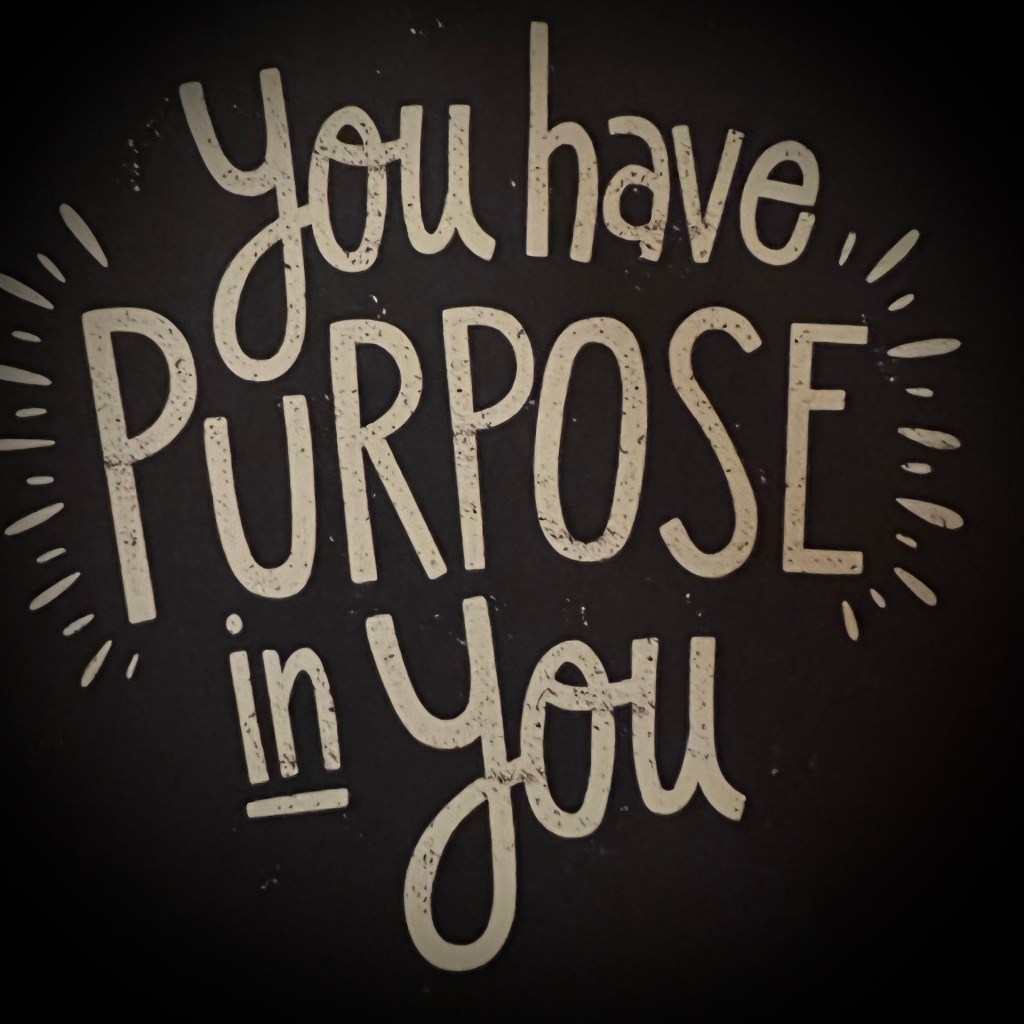
My response
when asked
about my
leadership style:
I seek
to inspire
for we are wired
to feel productive
to have purpose
to believe
in what we do
in who we are
and why
therein lies
the candle
of purpose
to be lit
by inspire
fire

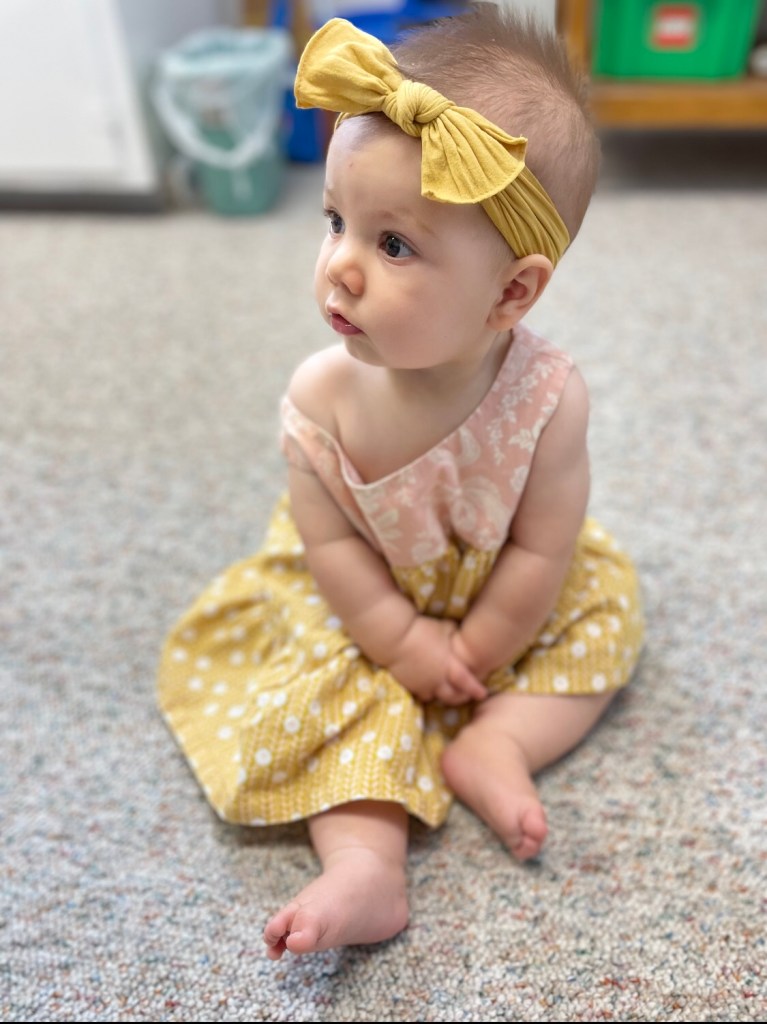
You cannot know
not yet
how your presence
has utterly transformed
my world
seven months
of pure wonder
every day new
purposed and poised
tied with a bow
oh but one day
one day
you’ll know
It is not what I expected in a meeting at the end of another long workday.
A series of self-care surveys.
Not so much the physical, psychological, and emotional ones.
The spiritual one…

There’s my word – awe!
‘Other’, for me: Write about all these things.
Which I do.
And my spirit sings.
Sunday is a stillness
in my week
not restful
for a pastor’s family
but restorative
and right
the church standing tall
like a father
doors like open arms
welcoming the penitent child
wrapping me
in belonging
Sunday is a stillness
in my spirit
ever how fierce or frayed
ever how dismayed
like a calming infusion
like a healing balm
the stillness seeps
so deep, so deep
for in all the unholiness
the holy remains
Sunday is a stillness
in my life
for the living
for the forgiving
for the remembering
for the mattering
for my walking in the footsteps
of those who walked before me
in the rhythms of grace
singing old songs of belief
through all our yesterdays
until our eternal Sunday
comes at last.
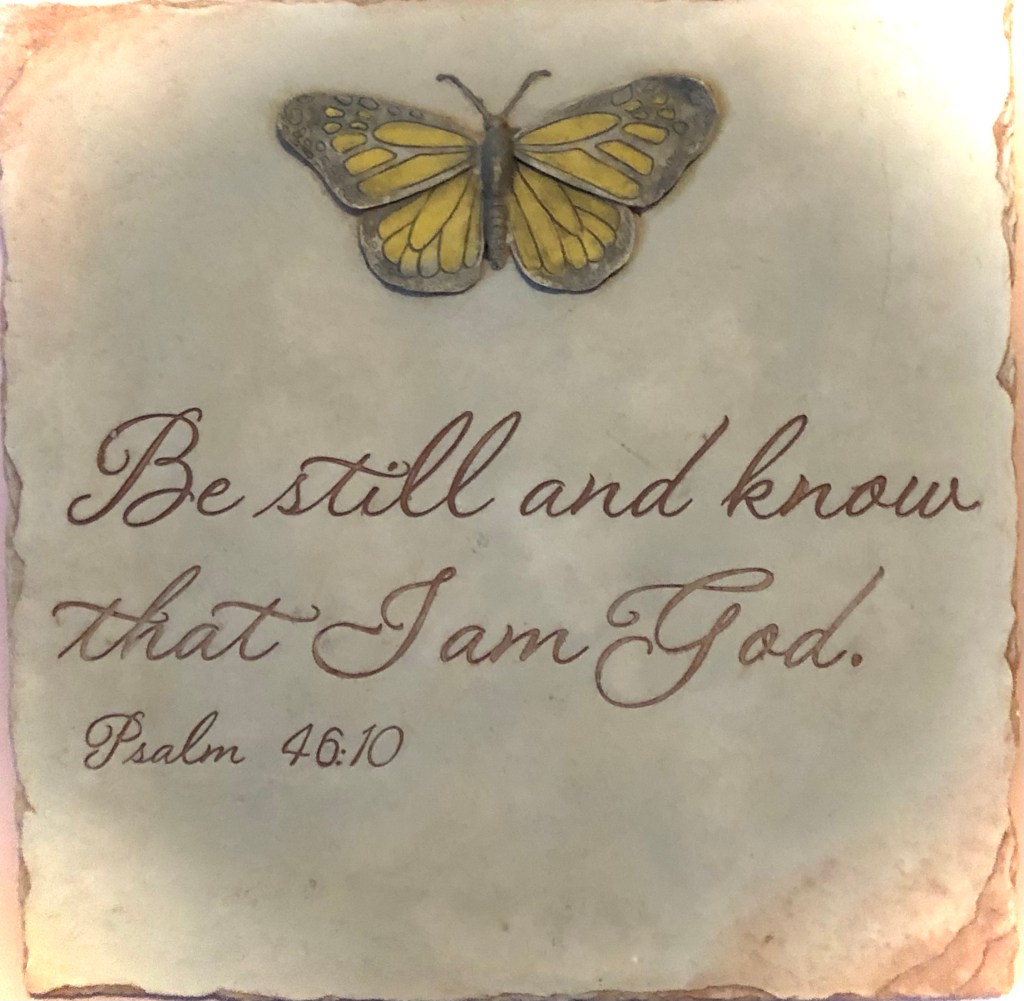
I once read of a young woman preparing her kitchen for Passover. Amid the traditional cleaning and purging, she had a sense of taking her place in the long line of women who had done so before her, throughout history. As if the rituals of tradition invoked their presence, for within the actions lie inextricable, unbroken threads of purpose, holiness, praise, gratitude…
On the eve of Thanksgiving, I have a similar sensation. Driving to the grocery store, armed with a list of ingredients for foods that my children have requested (deviled eggs and carrot cake chief among them), I am enchanted by autumn’s alchemy. Late afternoon sun gilds the trees along the roadside. The blending of red, orange, bronze, some trees already bare, preparing for winter…for a moment, for mere seconds, I imagine there are figures running through these flickering sunlit woods. If I could look long enough, or just right, I might catch glimpses of people as they were in times past, maybe even my childhood self. Burnished memories still living, beckoning…snapshot scenes of Thanksgivings, with card tables set up for the children. Heads bowed in prayer. My grandfather’s humble blessing, his knobbled, work-worn hands. Grandma’s deviled eggs and potato salad, Mama’s carrot cake (the hit of every holiday gathering), Grannie’s rum pound cake…lifting that big old Tupperware lid, the first whiff nearly knocking me down, but the moist golden richness after…incomparable. I find myself yearning for a slice of it now.
In the process of cleaning and preparing for the holidays I reorganized a closet. I found a box of Grandma’s things. Letters and cards given to her over the years, her green-bronze jewelry box containing her clip-on “earbobs”. Old photos. Books and trinkets I’d given her. Her diaries, dating back to when I was twelve. Programs from my school plays. Her funeral program. And I think about how life is the story of love, sacrifice, survival. How she and Grannie did much with little, raising children during the Great Depression. How they held faith and family above all else…how they do not feel far from me, even now, as I write these words. My own granddaughter, their great-great granddaughter, will be four weeks old on Thanksgiving Day. I have a profound sense of taking my place in a hallowed line of legacy and love. With abiding gratitude. And joy, shining like the immutable sun on the autumn trees, in the ongoing story of survival. The turning of pages, new chapters, in a gilt-bound book…
Here’s to all the blessings that were, are, and are still to come.
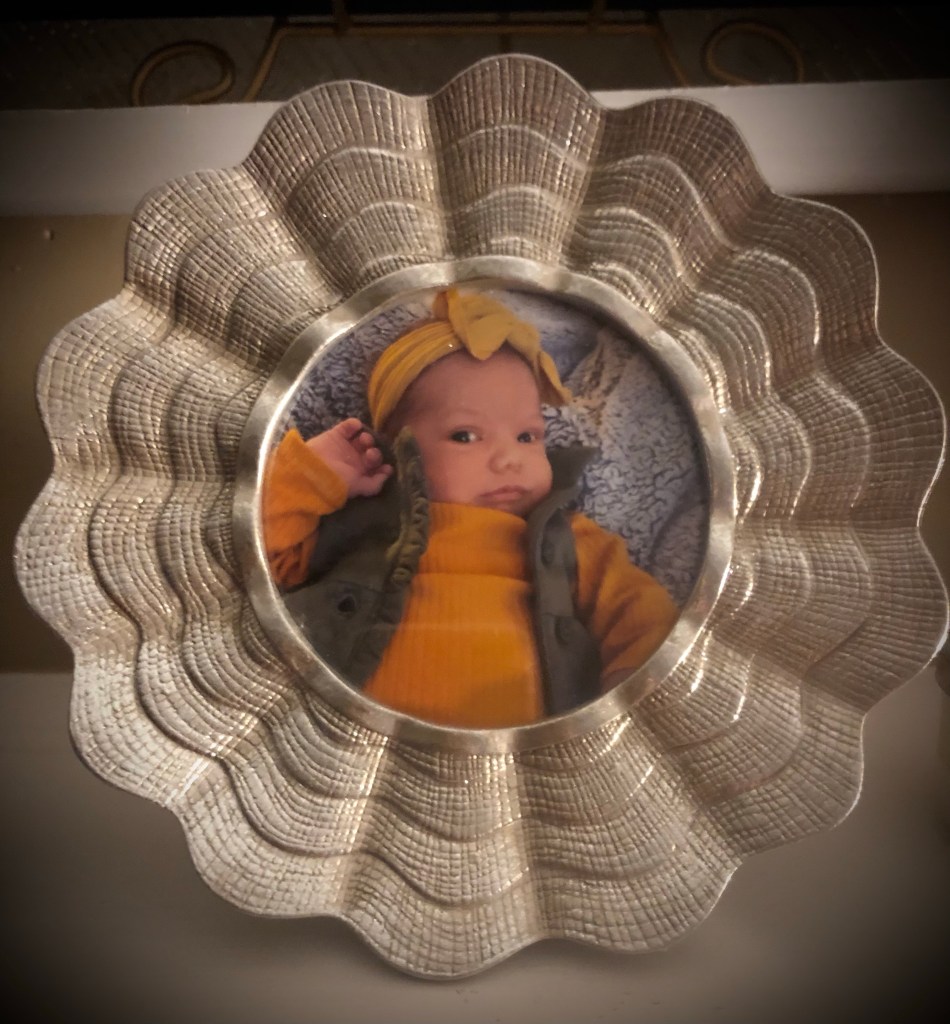
Our precious Micah


“Jerusalem” donkeys live in a pasture near my home. They are so named for the cross formed by black stripes across their shoulders and down their backs. The donkey is a symbol of peace, for they are peaceable creatures, although farmers know they will protect livestock by driving away coyotes.
The donkey currently plays a significant role around the world with the observance of Palm Sunday and Holy Week. The Gospels of Matthew and John both proclaim the fulfilling of Zechariah’s prophecy that the Messiah would come to Jerusalem humbly, riding the foal, or colt, of a donkey. In Mark and Luke, Jesus directs his disciples to a colt “on which no one has yet sat.” Only Matthew records that the unbroken colt doesn’t come on this mission alone: Its mother walks alongside as it carries Jesus through the shouting crowds in the streets of Jerusalem.
It is the image of the mother walking beside her colt—her child—as a calming presence amid chaos, as a needed coach in fulfilling the sacred duty, that suddenly pierced my heart and inspired today’s post.
Walk with Me
My world is confined
to the home that I know
until strangers come
to lead me away
—please, will you come with me,
walk with me?
I know not the destination
only that it’s far
beyond what I can see
and I can’t go it alone
—I need you by me,
to walk with me.
The crowds, the fervor,
what can it all mean
but that I’m not safe
in this place of screams
—don’t leave me now!
Just walk with me.
Such heavy burdens in this
untamed human world
some worthy, some not.
What’s the difference?
—Show me, I am watching you
walk with me.
A step and a step and a step
at a time,
I find I can carry on
as long as you are here
—because you don’t fear
to walk with me.
It is new to me,
my burden; but it is light
despite the shadows
you are at peace
—and so am I
for you walk with me.
I know, somehow,
you’ll see me home
when this day, these cries,
this purpose, are done
—so walk with me
walk with me
keep me ever close
and
walk with me.
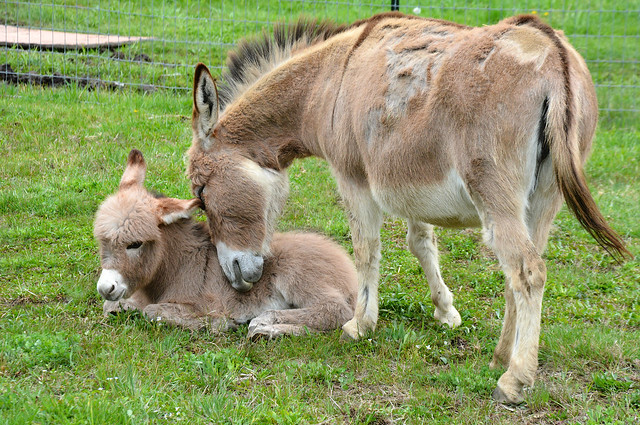
Mother & baby Jerusalem donkeys. Barbara Bresnahan. CC BY-SA

Why. Bruce Krasting. CC BY
Last Friday at school our professional development centered on finding our whys. For we are not made of what we do; we’re made of why we do it.
In a YouTube video, comedian Michael Jr. puts it this way: “When you know your why, you have options on what your what can be.” To illustrate the difference between knowing what and knowing why, he calls on a member of the audience (a school music director by the name of E. Daryl Duff) to sing a few bars of “Amazing Grace.” Duff’s voice is resonant, beautiful. Michael Jr. then asks Duff to sing as if a couple of specific, tragic things had happened to him; the transformation is stunning. Duff sings in a higher key with a vibrato full of emotion and energy—see the “Know Your Why” video).
It’s a perfect example of how our power, our potential, lies in knowing why we do things.
So, my colleagues and I got to work on finding our whys.
We were to map at least five peaks and valleys in our lives; if we needed help, we could use a memory prompt based on the work of Simon Sinek:

Our principal modeled the activity first (let us remember that good teaching and good writing have a primary rule in common: Show, don’t tell). The peaks and valleys didn’t necessarily have to be milestones in our lives, but experiences surrounded with much meaning or emotion, maybe turning points, times we gained knowledge that changed us. The more specific we could be in listing several significant life events or people that made an impact on us, the better we’d get to our why.
Mulling the suggestions and the need for specificity, I chose these events, people, and moments that first came to mind as being beyond the norm:

Thinking of such experiences and writing them can be emotional, but sharing is where the emotion really kicks in.
Laughter. Tears. Reassuring hugs.
In pairs who were moderately comfortable with each other, but who didn’t know each other really well, we shared some of our peaks and valleys. We didn’t have to share everything we wrote, just the items we wanted to share. We told why we chose these points in our lives and what stood out about them. While one partner read, the other listened for connections or patterns in those life events, made notes, and then the roles switched.
We then shared what we discovered about one another.
In my case, my father’s sudden death (my lowest valley), reading “The Murder of Robbie Wayne, Age 6” in The Reader’s Digest when I was a young teen, my birthday party when my mother invited a boy who had bullied me, and a boy who did one of the greatest acts of kindness I’ve ever seen back when we were in 5th grade (I wrote about it: The Valentine) all connect to my present notions of fairness, doing what’s right, and being an advocate. My having asthma as a child, my husband’s loss of an eye to disease two years ago, and my return to college to finish after a span of many years have a common theme of overcoming. The others—my husband’s ministry, my grandmother’s belief in me, my volunteering to do a play with elementary students when I was still in high school, my blog, the professional development I’ve led in writing, my boys’ individual accomplishments in music and leadership, and the high school teacher who saved the lead role in The Matchmaker for me to read in class—are tied to inspiration.
Synthesizing all of this leads to drafting a why statement comprised of our contribution and our impact:
To _____________________ [contribution] so that ___________________________ [impact].
Mine, at the moment, is this (still working to tighten it further):
To inspire others so that they know they can overcome obstacles and setbacks.
This is why I do what I do; some of the whats are literacy coaching, encouraging others to write, and writing this blog.
I wonder, now, how many colleagues—how many people in the world, actually—have their whys and whats aligned. Seems to me there’d be incredible frustration, anger, anxiety, depression, imbalance, and utter lack of fulfillment when whys and whats aren’t aligned, when people don’t recognize their contribution or see the impact they can make. I think of people in jobs that don’t match their whys and how such dissonance makes for misery.
In The Art of Coaching, Elena Aguilar writes of a teacher struggling with classroom management. The man couldn’t bring order because, when he was in school, he suffered being stereotyped and devalued by a teacher. Being the authority figure for his students felt like he was doing the same to them. He went into teaching because he had a genuine love for the kids, but his core beliefs, his why, the very essence of who he was, wouldn’t allow him to establish the needed structure.
He couldn’t change his why; he could only change his what. He ended up leaving the teaching profession.
“When you know your why, you have options on what your what can be.”
We are not what we do.
We are why we do it.
Knowing that, as Robert Frost might say, makes all the difference.
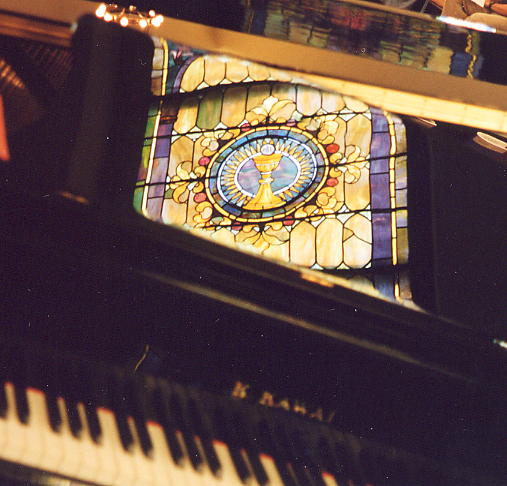
Piano & window. Alan Mayers. CC BY-SA
Years ago, a woman – tired, seven months pregnant – sat in the front row of a church. The morning sun shone through the stained glass windows, casting jewel-tone light on the baby grand piano, a soothing sight to the weary woman whose busy child was churning her insides. The pianist took a seat and began to play the prelude.
The baby stopped moving. He or she didn’t move again until the prelude ended. After the final notes, the child resumed the high activity.
The baby hears the music, thought the mother, marveling. It was the first of many times she would notice the unborn child’s response.
Around age three, the boy frequently hummed a tune to himself. His mother recognized it: “Amazing Grace.” When he was four, the child started playing cassette tapes of gospel music that had belonged to his great-grandfather. After his fifth birthday, his mother stood in the doorway of his bedroom, watching the boy making tally marks with a dry erase marker on a whiteboard easel.
“What are you doing?” she finally asked.
“I’m counting the syllables,” her boy replied, with a serious expression on his little face. He continued his business, listening to the tape, steadily making marks.
It’s the beats, the mother thought. He’s counting the beats.
When he brought home his “All About Me” book on finishing kindergarten, his parents smiled at this page:
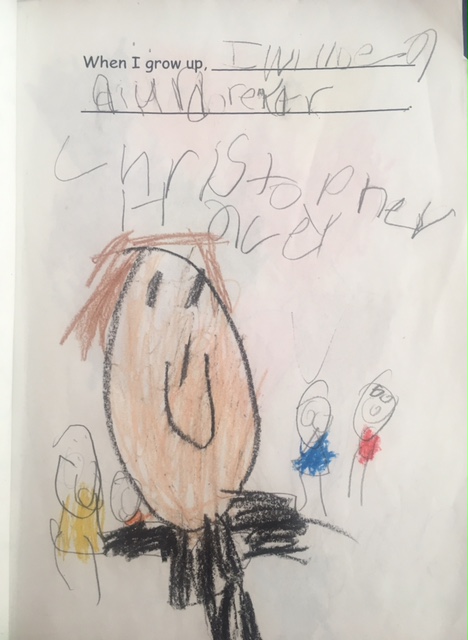
“When I grow up, I will be a qiur drekctr (choir director).”
When he was seven, watching him tinker occasionally on his great-grandmother’s upright piano in the living room, his mother said, “You love music so much – why don’t you take piano lessons?”
The boy shrugged, something of a disappointment to his mother, who expected he’d be excited. She took him to lessons anyway.
He wouldn’t practice. The lessons were abandoned before long.
His mother was sad.
In middle school, the boy decided to play alto sax in band. He began tinkering with the piano a little more. Then one day, when he was fourteen, he said, “Hey, Mom, listen to this.” And he played a medley of Christmas songs on the piano – both hands, all the parts – as if he’d been doing so all of his life.
His mother stood marveling, knowing, tears in her eyes.
The boy played the medley on the baby grand piano for the prelude at church on Christmas Day, to the astonishment of the congregation.
He played alto and bari sax for marching band throughout high school; he developed a love for jazz. Few of his friends knew he could play the piano as well. None knew he could sing. One of his teachers did, however. She sought him out when she couldn’t find sheet music for a song she planned to perform at Senior Awards Day.
“This is a version of ‘Perfect’ by Pink – do you think you can play it?” she asked the boy.
“I think so,” replied the boy.
He had two days to prepare.
The result:
One week after graduation, he was hired as the director of music programs at a church, fulfilling his childhood desire of being a choir director.
The rest of the story remains to be written, as it is still unfolding.
I am excited to see where the music takes you throughout your life, Son. Keep learning and reaching.
Much love –
Your infinitely proud mom.
Reflect: Few of us know what we are meant to do so early in life. It’s never too late to find out. What are your dreams, the things that bring you the most fulfillment? Pursue them! What are your gifts? Use them to benefit others. Encourage them to do the same.